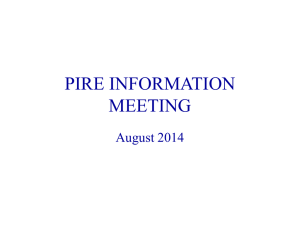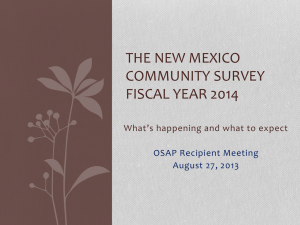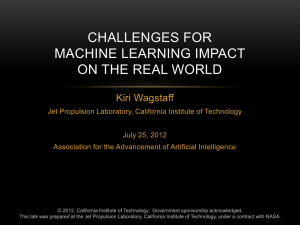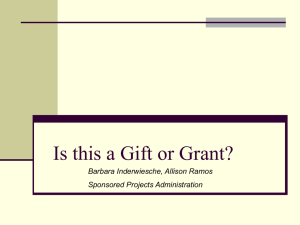Application of environmental offsets for treated - UCI Water-PIRE
advertisement
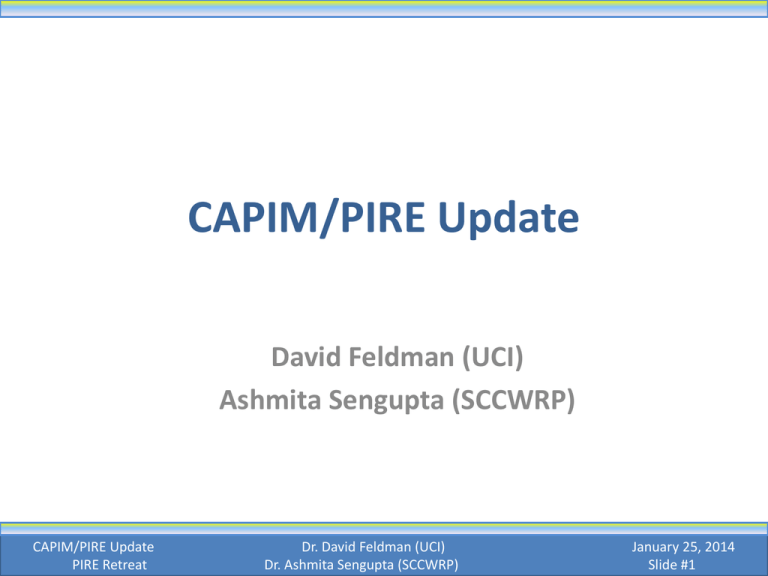
CAPIM/PIRE Update David Feldman (UCI) Ashmita Sengupta (SCCWRP) CAPIM/PIRE Update PIRE Retreat Dr. David Feldman (UCI) Dr. Ashmita Sengupta (SCCWRP) January 25, 2014 Slide #1 Transitioning to Integrated Water Resource Management (IRWM) from Traditional Practices Integrated Water Resources Management CAPIM/PIRE Update PIRE Retreat •Driven by need to develop holistic approach to sustainably manage diverse water resource issues. •Focus on community learning and place-based solutions. •Innovative, integrated resource frameworks that capture social, economic, as well as environmental elements. •Highly applicable to semi-arid climates. Dr. David Feldman (UCI) Dr. Ashmita Sengupta (SCCWRP) January 25, 2014 Slide #2 PIRE-CAPIM Collaboration UCI • Center for Aquatic Pollution Identification and Management: based at University of Melbourne • New technologies to improve monitoring, identify priority pollutants, detect sources of major pollutants and assist in management of pollution issues • Experience with reclaimed water offset scheme- saved Melbourne Water $80 M (Upper Dandenong Project) CAPIM/PIRE Update PIRE Retreat Dr. David Feldman (UCI) Dr. Ashmita Sengupta (SCCWRP) January 25, 2014 Slide #3 CAPIM’s Study Area: Jacksons Creek Catchment CAPIM/PIRE Update PIRE Retreat Dr. David Feldman (UCI) Dr. Ashmita Sengupta (SCCWRP) January 25, 2014 Slide #4 Jacksons Creek Catchment: Site of Interest CAPIM/PIRE Update PIRE Retreat Dr. David Feldman (UCI) Dr. Ashmita Sengupta (SCCWRP) January 25, 2014 Slide #5 Australian Smart Water Fund for Water Quality Offsets Framework • Australian Smart Water Fund issued a bid for funding an IWRM Framework based on Jacksons Creek Experiment • Key stakeholders – Victorian Water Industry, regional partners, EPA, DEPI, OLV, CAPIM, Local Government) • PIRE partnered with CAPIM to respond to RFP Source: Smart Water Fund RPF CAPIM/PIRE Update PIRE Retreat Dr. David Feldman (UCI) Dr. Ashmita Sengupta (SCCWRP) January 25, 2014 Slide #6 NSF PIRE-CAPIM Project Goal Conduct integrated assessment of environmental, social, and economic components of water management strategies in Jacksons Creek Watershed as a foundation for understanding use of environmental offsets on a broader scale. Key Questions: 1) What are the social and environmental impacts of the current offset scenarios in Jacksons Creek? 2) What are optimal strategies for achieving net positive societal, economic, and environmental benefits in the watershed (and what are their lessons)? 3) What are impediments/opportunities to applying such strategies to other locations (e.g. Southern California)? CAPIM/PIRE Update PIRE Retreat Dr. David Feldman (UCI) Dr. Ashmita Sengupta (SCCWRP) January 25, 2014 Slide #7 Watershed/water quality model to evaluate trade offs Phase 1 Develop a conceptual framework Decision Tree Analysis Social/political Evaluation Optimal Strategies Economic Evaluation Watershed/water quality model Phase 2 Explore Scenarios Social/political Evaluation Decision Tree Analysis Optimal Strategies Economic Evaluation Phase 3 Expand framework based on scenario analysis Apply to other sites (Australia and Southern California) Benefits/ Impediments Conceptual Framework (under construction) Demographic changes, economic activities, Land use Design offset decisions, other management decisions Water Management Climate change Reduce Recycle Reuse Indicator and acceptable tradeoffs Human Health Ecological Responses Impacts (social, and economic) CAPIM/PIRE Update PIRE Retreat Benthic/Eutrophication Micropollutant Toxicity Changes in human perception, attitudes, and behavior Dr. David Feldman (UCI) Dr. Ashmita Sengupta (SCCWRP) January 25, 2014 Slide #9 Options for Capturing Value Traditional Willingness to Pay • Standard, contingent value approach • Limited in terms of value capture Place-based, Intrinsic Value • Designed to capture intrinsic value of cultural, historic, and ecological assets • Community generated list of assets produces ranked list of preferences Interactive, Game Theory • Workshop participants engage in WTP exercise based on interactive, game theoretic model • Consequences to WTP decisions are immediate CAPIM/PIRE Update PIRE Retreat Dr. David Feldman (UCI) Dr. Ashmita Sengupta (SCCWRP) January 25, 2014 Slide #10 Typology for Public Participation in Integrated Assessments Mapping Out Diversity Scientistsstakeholder workshop Focus Groups Participatory Modelling Process as a goal Policy Exercises Scenario Analysis Process as a Means Citizen’s Juries Participatory Planning Consensus Conference Reaching Consensus CAPIM/PIRE Update PIRE Retreat Dr. David Feldman (UCI) Dr. Ashmita Sengupta (SCCWRP) Source: van Asselt Marjolein & Rijkens-Klomp (2002) January 25, 2014 Slide #11 Timeline and Products • Year 1 Year 2 Years 3, 4 CAPIM/PIRE Update PIRE Retreat • Develop conceptual framework and identify framework assessment indicators Conduct interviews Compile existing data Assessment of biological impact of Jacksons Creek offsets Develop watershed/water quality model for Jacksons Creek Perform decision tree analyses • • • • Incorporate climate change modeling Explore scenarios Focus group interviews to assess options Continue decision tree analyses • Apply framework to other test cases (Southern California) • • • • Dr. David Feldman (UCI) Dr. Ashmita Sengupta (SCCWRP) • • • • Publications Conference presentations User workshop Integrated Assessment Framework January 25, 2014 Slide #12 Thank You Questions? Contact feldmand@uci.edu ashmitas@sccwrp.org CAPIM/PIRE Update PIRE Retreat Dr. David Feldman (UCI) Dr. Ashmita Sengupta (SCCWRP) January 25, 2014 Slide #13 Identification of Potential Stressors Endpoints Measured Key Outcomes Water Chemistry Nutrients, Pesticides, Estrogenicity Identify potential stressors Discharge Water Nutrients, Pesticides, Estrogenicity Identify potential stressors Sediment Chemistry Nutrients, Hydrocarbons, Pesticides Identify potential stressors Toxicity Algal Inhibition Macroinvertebrate Impairment Identify if pollutants are negatively impacting the flora and fauna Faunal Alteration Macroinvertebrate Impairment Fish Impairment Identify the condition of fauna Endocrine Disruption Macroinvertebrate Impairment Fish Impairment CAPIM/PIRE Update Up Down Under Retreat Identify if endocrine disrupting chemicals are affecting faunal condition Dr. David Feldman (UCI) Dr. Ashmita Sengupta (SCCWRP) January 25, 2014 Slide #14

